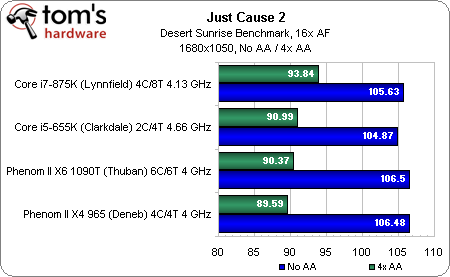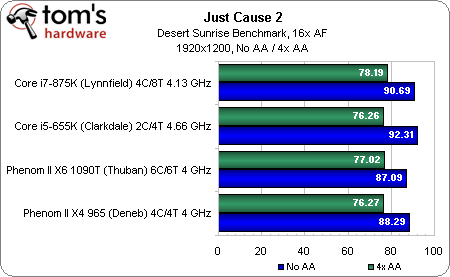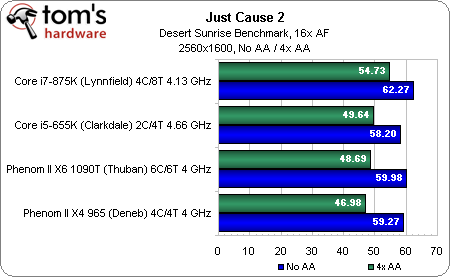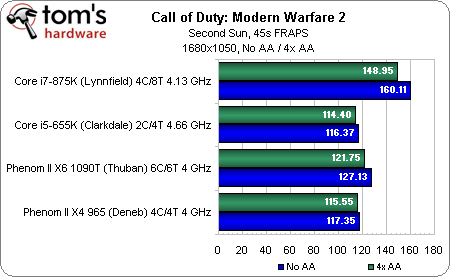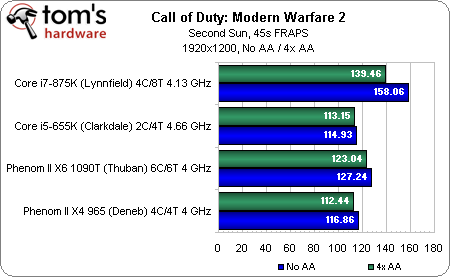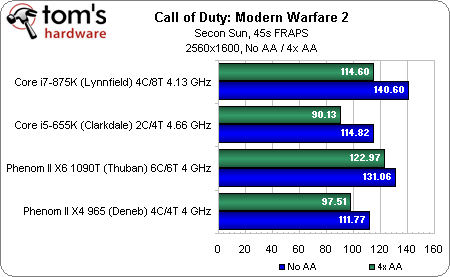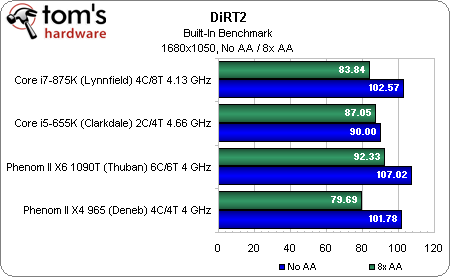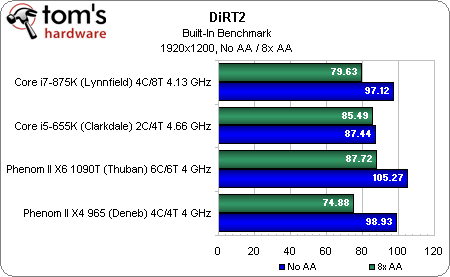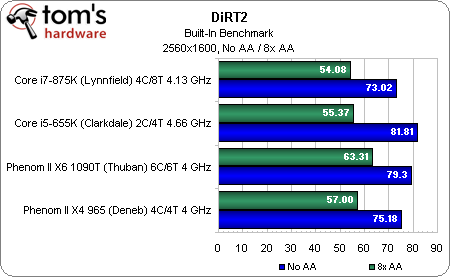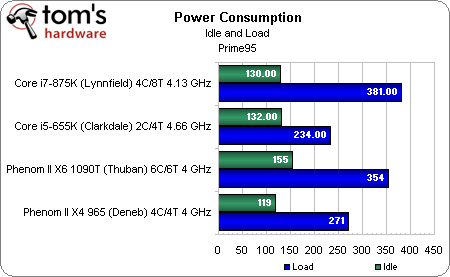
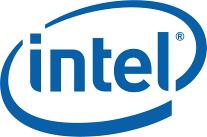

|
TopNax |
|
Home Previous AMD page Intel page Next |
Benchmark Results: Just Cause 2 |
|
With anti-aliasing turned on, all the way through 2560x1600, the quad-core i7-875K turns in the best performance, followed by Intel’s Core i5-655K. Conversely, with AA turned off, the scores jump around a bit, but remain in a fairly tight range. |
Benchmark Results: Call Of Duty: Modern Warfare 2 |
|
Again we see the Core i7-875K put in a strong showing at 1680x1050 and 1920x1200. By the time we hit 2560x1600, the Phenom II X6 has almost caught up, though all four platforms still deliver more than enough performance for smooth game play. |
Benchmark Results: DiRT 2 |
|
AMD’s CPUs do well here—enough so that it’d be hard to make a recommendation one way or the other based on DiRT’s results alone. Generally, though, the Phenom II X6 1090T seems to come in ahead with 8xAA turned on, which is probably the setting you’d want to use with such a high-end combination of |
Power Consumption |
|
As we increase the voltage supplied to hit higher clock rates, the power consumption of these processors increases beyond the specs set forth by AMD and Intel. Every CPU is different of course, but we generally noticed higher idle power numbers across the board versus past processor reviews with chips running at stock settings. Of course, you have to be careful in comparing this setup to the one used in my Phenom II X6 1090T story, for example. We’re using twice as much memory, a dual-GPU graphics card, and a much more aggressive processor cooler. Under load, the Core i7-875K uses the most power, followed fairly closely by the Phenom II X6. Even at 4.66 GHz, the 32 nm Core i5-655K is much easier on the energy bill |
Conclusion |
|
Drawing conclusions on this one is surprisingly easy. Intel gets major kudos for going somewhere it has never gone before: opening up enthusiast-class flexibility to the folks who don’t have $1,000 to spend on a new CPU. It wouldn’t be fair to sarcastically toss out a, “way to join the party, Intel.” Remember that once upon a time, AMD only unlocked its $1,000 FX-series chips, too. But getting eclipsed on the performance front encourages creative thinking. The fact that Black Edition CPUs are available under $100 is less altruistic and more strategic.
At the end of the day, it’s all good news for enthusiasts, who now have more choice and more flexibility at price points they can more realistically afford. …versus Intel If you’re looking at Intel’s product stack, these new chips (particularly the Core i7-875K) are just what the doctor ordered. I mean, I wouldn’t have ever suggested that a 2.93 GHz Core i7-870 was a good buy at $562 when the 2.8 GHz Core i7-920 was selling for $294. But a Core i7-875K at $342 is at least a little more attractive if you’re using that $562 price point as a reference. At the same time, an unlocked Core i5-655K at $216 doesn’t sound daunting at all. For a processor that ran stable for us at 4.66 GHz, you couldn’t really ask for sweeter dual-core chip to take the place of Intel’s Core 2 Duo E8500 and E6300 in the annals of overclocking history. At the same time, we have to wonder why Intel picked the SKUs that it did for K-series honors. Tom’s Hardware’s favorite overclockable Core i7 remains the LGA 1366-based -920 (or -930). Our favorite i5 remains the -750. Either one of those models, unlocked, could have been priced similarly, opening up X58’s PCI Express connectivity at the high-end, and giving enthusiasts a true quad-core LGA 1156 CPU with which to play, even if it’s a more-expensive-to-manufacture 45 nm design. …versus AMD
And that leads to the inevitable comparison to AMD’s Black Editions. Versus the Core i7-875K, overclocked, AMD’s six-core Phenom II X6 1090T is generally outperformed at 4 GHz. But it’s also $30 cheaper. It also takes off in heavily-threaded video encoding titles. And it also populates a platform well-endowed with PCI Express 2.0. While you could easily set the Core i5-655K up against AMD’s Phenom II X6 1055T, we chose the quad-core Phenom II X4 965 instead, which also hit 4 GHz stably. Threaded titles uniformly favored AMD’s offering, while workloads like iTunes gave the 32 nm chip’s insane 4.66 GHz clock the advantage. Again, though, Intel is asking an extra $35 over AMD’s price of entry. Bottom Line As enthusiasts, we’ll again emphasize how happy we are to see Intel unlocking processors beyond its Extreme Edition parts. But despite the excellent scaling you get from the company’s more advanced manufacturing technology, AMD’s Black Edition parts still come across as better values for the money, even when you overclock both parties involved to the limits of stability. With a slight massage to each model's price point, though, this story could easily turn back around and go the other direction. The K-series chips give Intel significantly more street cred. Here's hoping the product family lives on and expands to include additional enthusiast-class parts. Follow Chris Angelini on Twitter for updates from the Tom's Hardware lab. Contest Info Win A CyberPower Core i7-875K-Based PC Worth $1,499 Intel Core i7-875K CPU Contest is limited to residents of the USA (Excluding R.I.) 18 years of age and older. Contest starts on May 27, 2010 9:00 pm, Pacific Daylight Time and closes on June 10, 2010 11:59 PM, Pacific Daylight Time. Results will be announced by June 16, 2010. The information you provide will only be used to contact you in relation to this contest. YOU MAY SUBMIT ONLY ONE ENTRY. MULTIPLE ENTRIES FROM THE SAME PERSON WILL ALL BE DISCARDED. |
|
Home Previous AMD page Intel page Next |
